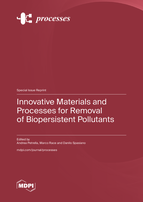Innovative Materials and Processes for Removal of Biopersistent Pollutants
A special issue of Processes (ISSN 2227-9717). This special issue belongs to the section "Materials Processes".
Deadline for manuscript submissions: closed (15 September 2022) | Viewed by 23827
Special Issue Editors
Interests: material recycling; inorganic compounds; wastewater treatment; photocatalytic materials; biopersistent pollutants; nanocomposites
Special Issues, Collections and Topics in MDPI journals
Interests: soil remediation; contaminants of emerging concern (CEC); wastewater treatment; soil management; hazardous waste
Special Issues, Collections and Topics in MDPI journals
Interests: nanomaterials; wastewater treatment; adsorption; solid waste management; soil remediation; photodegradation; degradation; wastewater reuse
Special Issues, Collections and Topics in MDPI journals
Special Issue Information
Dear Colleagues,
Endocrine-disrupting compounds are emerging micro-pollutants produced by industrial practices and anthropogenic activities. These contaminants are of inorganic and organic natures (pharmaceuticals, food sources, potential toxic metals, dyes, personal care products, detergents, flame retardants, cosmetics, and pesticides) with potential toxicological effects on the human health and the environment (air, water, and soil) due to their ubiquity at trace levels. Endocrine disruptors are substances that can interfere with the hormonal system and thereby produce harmful effects in both humans and wildlife.
These molecules could be bio-persistent during conventional treatment processes; accordingly, the adoption of proper and innovative technologies are necessary for the removal of these hazardous, persistent chemicals before their release into the environment.
The aim of this Special Issue is to collect research devoted to the recent progress and new perspectives in the processes of treatment and removal of these hazardous artificial (xenobiotic) contaminants in air; soil; and water supply.
To this end, it is my pleasure to invite you to submit a manuscript for this Special Issue.
Full papers, communications, and reviews are all welcome.
Dr. Andrea Petrella
Dr. Marco Race
Dr. Danilo Spasiano
Guest Editors
Manuscript Submission Information
Manuscripts should be submitted online at www.mdpi.com by registering and logging in to this website. Once you are registered, click here to go to the submission form. Manuscripts can be submitted until the deadline. All submissions that pass pre-check are peer-reviewed. Accepted papers will be published continuously in the journal (as soon as accepted) and will be listed together on the special issue website. Research articles, review articles as well as short communications are invited. For planned papers, a title and short abstract (about 100 words) can be sent to the Editorial Office for announcement on this website.
Submitted manuscripts should not have been published previously, nor be under consideration for publication elsewhere (except conference proceedings papers). All manuscripts are thoroughly refereed through a single-blind peer-review process. A guide for authors and other relevant information for submission of manuscripts is available on the Instructions for Authors page. Processes is an international peer-reviewed open access monthly journal published by MDPI.
Please visit the Instructions for Authors page before submitting a manuscript. The Article Processing Charge (APC) for publication in this open access journal is 2400 CHF (Swiss Francs). Submitted papers should be well formatted and use good English. Authors may use MDPI's English editing service prior to publication or during author revisions.
Keywords
- innovative materials
- environmental sustainability
- wastewater
- soil remediation
- air pollution
- contaminants fate
- adsorption
- treatment technologies and processes








